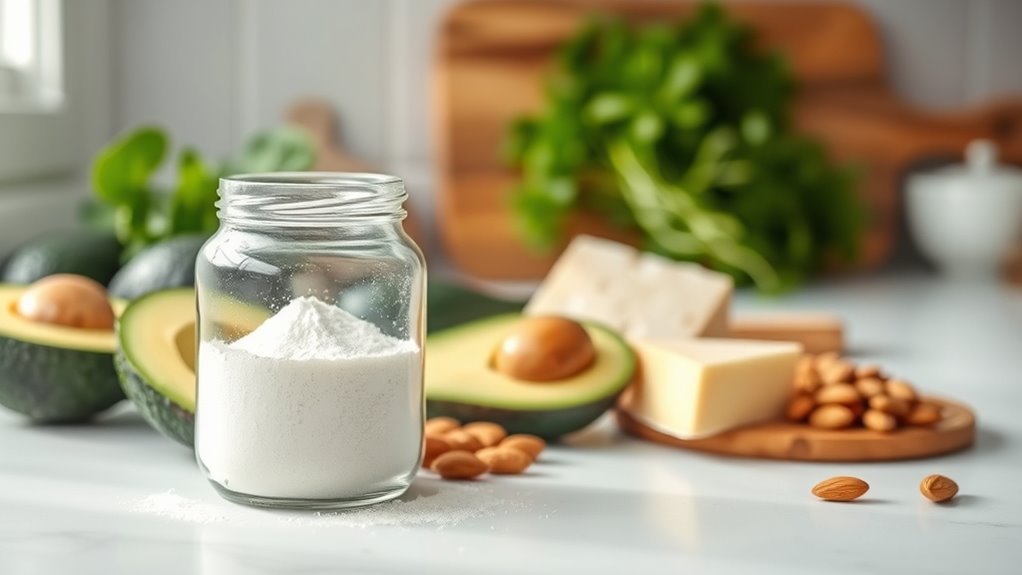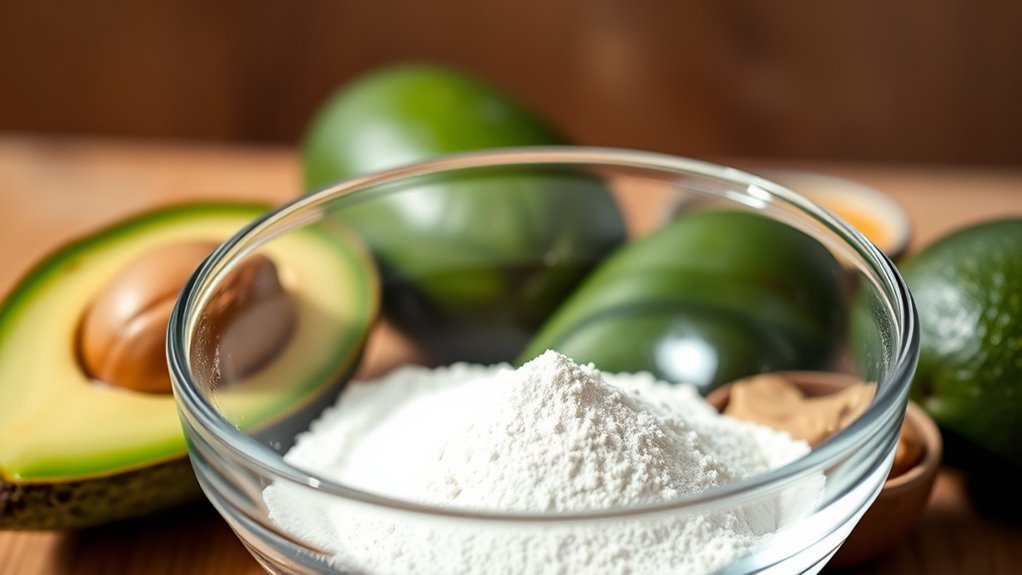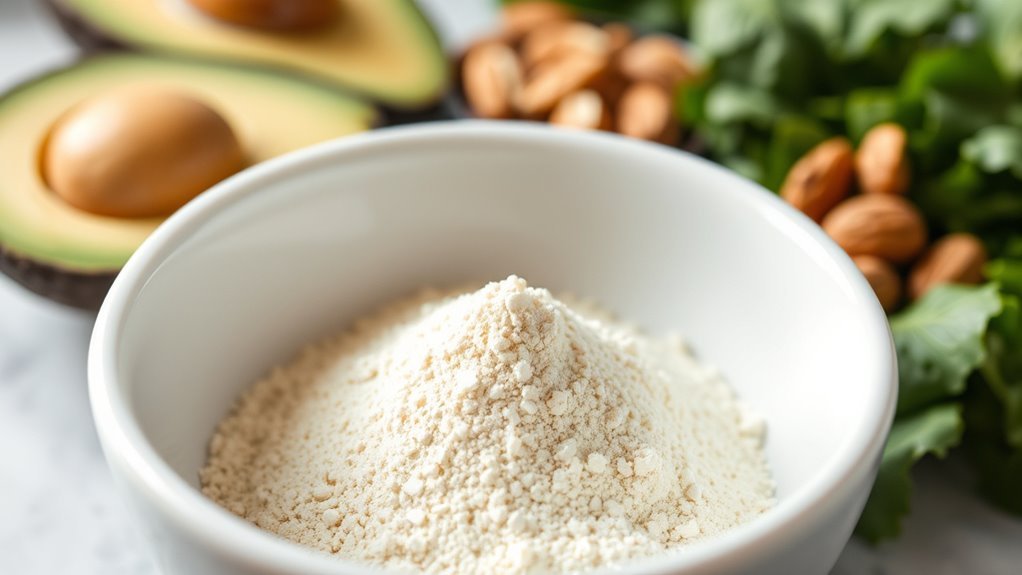Maltodextrin isn’t considered keto-friendly. It has a high glycemic index of 85-105, which can lead to rapid spikes in blood sugar levels, disrupting ketosis. Elevated blood sugar inhibits ketone production, shifting your body’s energy source from fat to glucose. While small amounts might be manageable, it’s important to pair it with high-fat foods and track your body’s response. There are better alternatives that can keep your blood sugar stable, so stick around to explore them further.
Understanding Maltodextrin: What Is It?

Maltodextrin is a carbohydrate derived from starch, commonly used as a thickener or sweetener in various food products. You’ll find maltodextrin sourced from corn, rice, or potato starch, making it widely available in the food industry. Its uses extend beyond just sweetness; it’s often added to processed foods, sauces, and snacks to enhance texture and improve shelf life. In sports nutrition, maltodextrin serves as a quick energy source, easily digestible and providing a rapid glucose release. However, while it has its benefits, it’s essential to evaluate its role in your diet, especially if you’re pursuing low-carb or ketogenic lifestyles. Understanding maltodextrin’s sources and uses can empower you to make informed dietary choices.
The Glycemic Index of Maltodextrin

While many people might not think about it, the glycemic index (GI) of a substance like maltodextrin plays an essential role in understanding its impact on blood sugar levels. Maltodextrin has a high GI, typically around 85-105, which means it can cause a rapid glycemic response. This swift increase in blood sugar can lead to elevated insulin levels, something you might want to take into account if you’re monitoring your carbohydrate intake.
| Glycemic Index | Effect on Blood Sugar |
|---|---|
| Low (0-55) | Minimal increase |
| Moderate (56-69) | Moderate increase |
| High (70+) | Rapid increase |
| Maltodextrin | 85-105 |
Incorporating this knowledge helps you make informed choices about your diet.
Impact on Ketosis: Does It Spike Blood Sugar?

How does maltodextrin affect ketosis? When you consume maltodextrin, its high glycemic index means it’s rapidly digested, leading to a significant spike in blood sugar levels. This surge can disrupt your state of ketosis, as your body shifts back to burning glucose for energy instead of ketones. Elevated blood sugar levels can inhibit the production of ketones, which are vital for maintaining ketosis. If you’re aiming for metabolic flexibility, it’s important to monitor your maltodextrin intake. While it may be convenient in certain foods, the impact on ketone levels can undermine your keto goals. To stay in ketosis, consider alternatives that don’t disrupt your blood sugar balance as much, ensuring you maintain that desired fat-burning state.
Comparison With Other Sweeteners
When considering sweeteners suitable for a ketogenic diet, it’s essential to compare their effects on blood sugar and ketosis. While maltodextrin can spike blood sugar levels, other sweeteners offer varying benefits and drawbacks. Here’s a quick comparison:
- Natural sweeteners like stevia and erythritol have minimal impact on blood sugar and are generally keto-friendly.
- Artificial sweeteners such as aspartame and sucralose can be calorie-free but may not suit everyone’s preferences.
- Honey is natural but high in carbs, making it unsuitable for keto.
- Agave syrup may seem healthy but can spike blood glucose.
- Remember to check individual responses, as sweeteners can affect people differently.
Choosing the right sweetener can help you maintain a successful ketogenic lifestyle.
Practical Tips for Using Maltodextrin on a Keto Diet
If you’re considering incorporating maltodextrin into your keto diet, it’s important to use it thoughtfully to minimize its impact on your blood sugar levels. Start by measuring out small amounts and tracking your body’s response. Consider using maltodextrin substitutes, like erythritol or stevia, for your keto recipes when possible. These alternatives can provide sweetness without the significant glucose spike. When you do use maltodextrin, pair it with high-fat foods to help mitigate its effects on insulin. Ultimately, keep your overall carb intake in check; moderation is key. Experimenting with different recipes can help you find the right balance while still enjoying flavorful meals. Your freedom to enjoy food can coexist with mindful choices.
Frequently Asked Questions
Can Maltodextrin Be Considered a Natural Ingredient?
Maltodextrin isn’t typically considered a natural ingredient. It’s derived from starch through a process that breaks it down into simpler sugars, often from corn, potato, or rice. Statistically, about 80% of food products with ingredient labeling include additives like maltodextrin. While it’s a common food thickener, it doesn’t come directly from nature in its final form, which may concern those prioritizing truly natural sources in their diet.
Is Maltodextrin Safe for People With Diabetes?
Maltodextrin isn’t generally considered safe for people with diabetes. Its high glycemic index can lead to rapid spikes in blood sugar, complicating diabetes management. When you consume maltodextrin, your body quickly metabolizes it into glucose, which can be problematic for maintaining stable blood sugar levels. It’s important to consult with a healthcare professional before including it in your diet, as they can guide you on managing your condition effectively.
How Is Maltodextrin Made?
Maltodextrin’s made through a process called maltodextrin production, which involves breaking down starches, usually from corn, rice, or potatoes. This is done via enzymatic hydrolysis, where enzymes convert the starch into smaller carbohydrate chains. The resulting powder is tasteless and easily soluble in water. It’s commonly used in food products for its thickening and stabilizing properties. Understanding how it’s made helps you make informed choices about its use in your diet.
Are There Any Health Risks Associated With Maltodextrin?
Imagine a ship steering through calm waters. While maltodextrin can smooth the surface, it might bring hidden currents beneath. The health implications include potential digestive issues for some, like bloating or diarrhea. It’s essential to recognize your body’s signals; if you’re experiencing discomfort, consider reducing your intake. Always consult with a healthcare professional to chart your course safely. Remember, what feels liberating for one might pose risks for another.
What Foods Commonly Contain Maltodextrin?
Maltodextrin’s commonly found in many processed foods. You’ll often see it as a food additive in snacks, sauces, dressings, and even some beverages. It acts as a thickener or sweetener, making it a popular choice in items like protein powders, energy drinks, and instant soups. Be aware of these maltodextrin sources when choosing your foods, as they can impact your nutrition and dietary goals considerably.


